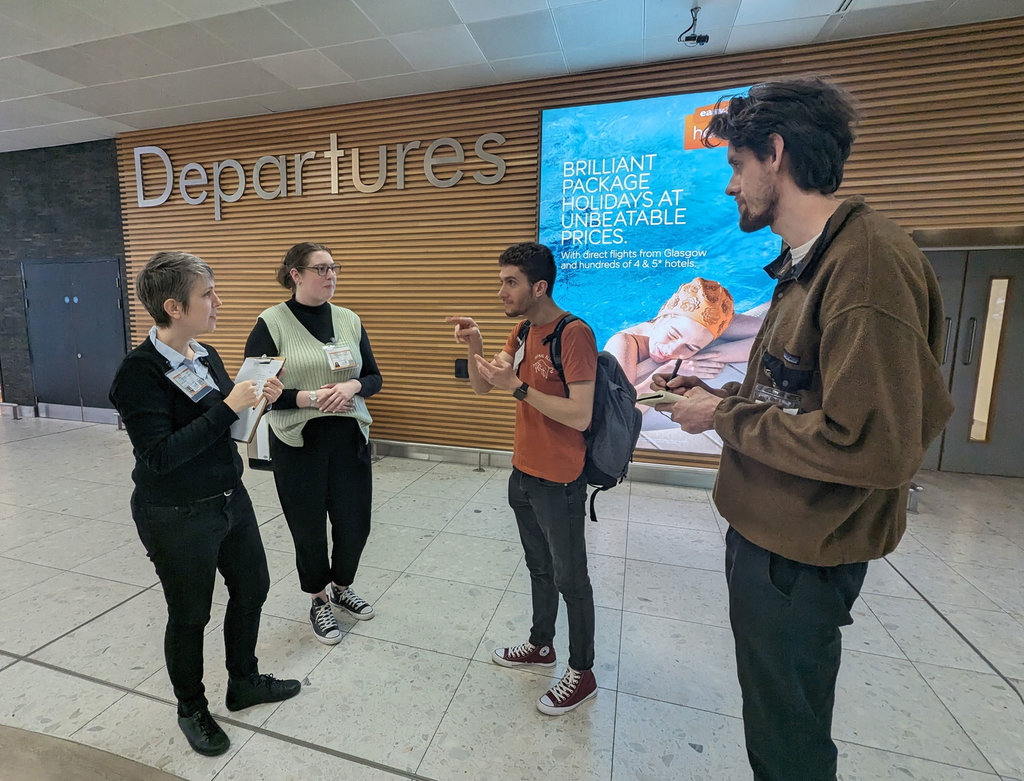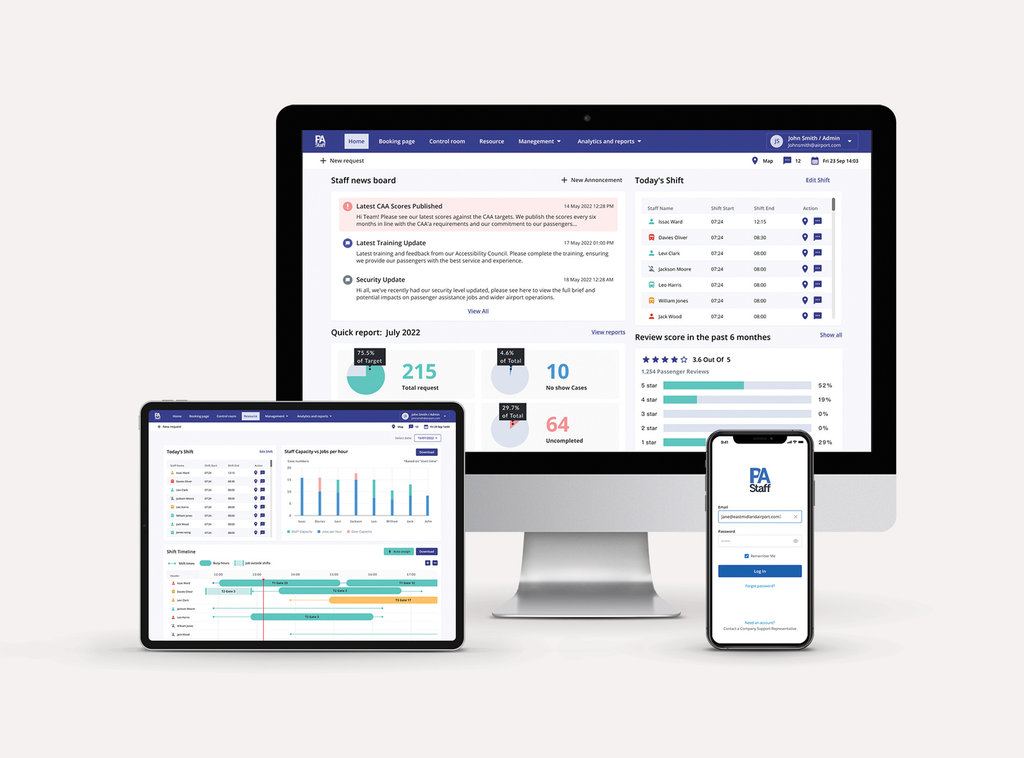Feature
The new tech improving accessibility at airports
The proliferation of smartphones in the last decade has led to a boom in new personal digital aides to improve accessibility in airports. Kirstie Pickering looks at some of the latest apps developed to help travellers with specific accessibility needs.
Greater accessibility at airports can transform the travel experience for passengers with additional needs. With more than one in five consumers having a disability, it’s important that airports continue to trial technology to make their operation as accessible as possible to all – and new innovations can further boost this offering.
Glasgow Airport has one of the highest percentages of people with disabilities and reduced mobility (PRM) passengers of any UK airport – last year, it welcomed more than 110,000 PRM passengers.
In March, Glasgow Airport worked with Connected Places Catapult, an innovation accelerator for cities, transport, and place leadership, on a series of accessibility technology trials. Its aim was to generate insights to aid the development of new solutions in this field.
Connected Places Catapult uses the ‘Social Model of Disability’, perceiving that people are disabled by societal factors – this means they refer to 'disabled people' or 'disabled passengers'.
“Disabled passengers are masters of their experience,” says Vasant Chari, director of human connected design at Connected Places Catapult. “They have told us about the sheer range of hurdles they face, from booking tickets to a safe return to home.
“The first and most obvious hurdle is in navigating the complicated journey through the airport. But we’ve also heard about challenges navigating digital interfaces at booking and requesting assistance, putting the passenger in a state of heightened anxiety before they’ve even stepped foot in the airport.”
New technologies improving accessibility
Chari says disabled passengers want choices, just like every other passenger – the accelerator has heard, for example, how some disabled passengers want to experience the shopping experience in many airports, but can find themselves whisked through airports, removing that choice from them.
“Technology can help passengers familiarise themselves with the airport and reduce travel anxiety,” he adds.

Glasgow trial.
“Virtual Reality (VR) means you can experience the airport journey from the comfort of your home. Augmented Reality (AR) can overlay information onto the physical space along with real-time information so that passengers can have information provided in context and in a timely manner.
“Artificial Intelligence (AI) powered by real-time data can help overcome challenges when things go wrong and the passenger needs a dynamic response to an unexpected or unplanned situation. AI can speed up translation of airport announcements into British Sign Language, too.”
Direct to passengers
With the proliferation of smartphones, apps have become an easy way to get new technology straight to passengers with additional support needs.
Transreport’s Passenger Assistance app is an accessibility assistance booking platform. Initially launched to support rail users, it has now expanded to those travelling through airports.
“The expansion of our app to cover aviation as well as rail means that airports and airlines will also be supported to deliver the best possible assistance to customers with access needs – and ultimately this leads to better and more inclusive air travel experiences for all passengers,” says Waleed Ahmed, COO at Transreport.
“Our solution has been designed to support airports to meet the standards set by the Civil Aviation Authority (CAA), ensuring consistent service quality.”
So, how does it work? Users can access Transreport’s Passenger Assistance technology via its app or website to request accessibility assistance. The request is sent to the airport’s staff web platform, where the booking is confirmed and assigned to a staff member or shift. The passenger is then notified of the successful booking.

Transreport's Passenger Assistance app and website is expanding to airports after success in the railway sector. Credit: Transreport
“Travelling often requires meticulous planning and consideration, which can be very time-consuming,” says Ahmed. “For many disabled and older passengers, the opportunity to communicate their access needs in advance can be both helpful and reassuring.
“Passenger Assistance was developed to alleviate these challenges. It allows passengers to easily request assistance through a single platform, eliminating the need to navigate multiple websites, contact call centres, or manage various booking processes. This streamlined approach saves passengers valuable time and reduces the complexity often associated with requesting assistance.”
Smart business
In addition to catering to passengers’ needs, such innovative technology also benefits airports and airlines by automating processes, simplifying system complexities, and enhancing communication among all stakeholders in the travel process.
AccessAble is an online guide that provides users with accessibility information to help them work out if a place is going to be accessible for their needs. Such technology is particularly valuable for airports, where those requiring assistance face many different types of hurdles.
The platform works with nine of the UK’s major airports to produce detailed access guides that feature both information and images covering factors such as parking, walking distances to restaurants, quiet spaces, accessible toilets, and assistive listening devices.
“We know everyone’s accessibility needs are different, which is why having detailed, accurate information is so important,” says Carrie-Ann Lightley, head of marketing and communications at AccessAble.
“This is why we send our trained surveyors to check out every single place in person and why the information we collect has all been decided by our user community.”
Each of AccessAble’s airport partners has a detailed access guide on the website, which has been used by over six million people in the last 12 months. The guides are also integrated into the airport’s own websites to ensure people find the information they need where they expect it to be.
“Detailed, accurate accessibility information is crucial to enable passengers to confidently and safely travel through airports,” adds Lightley. “The guides can benefit airports and airlines too by increasing revenue, attracting new passengers, saving costs and time, and reducing passenger complaints.”
With new technologies constantly evolving, it’s important that airports stay mindful of the impact innovation can have on its passengers requiring assistance.
Research by disability equality charity Scope found that 75% of consumers with a disability have decided against using a UK business because of poor accessibility, meaning transport businesses could potentially lose around £42m per month by ignoring the needs of disabled people.
“It makes business sense,” concludes Chari. “Remember, there are so many ways that people are disabled by society – there can be hidden disabilities that are dissuading people from flying. It always makes sense to make your experiences flexible for your customers and future customers.”